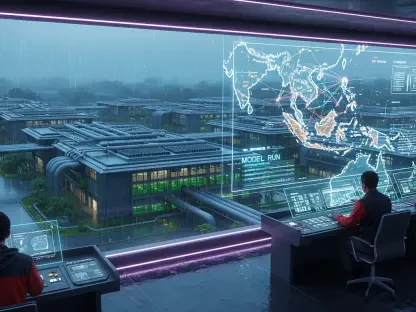Laurent Giraid, a renowned technologist with a deep focus on artificial intelligence and its many applications, sits down with us today. Having recently contributed to a groundbreaking study on driver stress using AI, Laurent’s work highlights critical aspects of urban design and road safety that could transform how cities approach traffic management. His expertise in machine learning and his dedication to ethically advancing AI make him an invaluable voice in this field.
Could you explain the primary objectives of your research regarding driver stress?
The main goal of our research was to understand how various visual elements of the urban driving environment impact stress levels in drivers. We sought to identify and analyze specific factors that contribute to driving stress, which could lead to better design of urban landscapes and influence the development of advanced driver assistance systems.
How did the UOC team use AI to study driver stress? What specific models or technologies were employed?
We employed a range of machine learning models to dissect the visual elements affecting driver stress. Our approach included using support vector machines and convolutional neural networks to analyze images, while temporal segment networks were utilized for assessing video data. This allowed us to comprehensively evaluate traffic conditions, urban features, and pedestrian presence in real-world scenarios.
What role does the visual landscape play in causing driver stress, according to your findings? Can you highlight specific elements of the urban environment that were significant stressors?
Our findings underscored the substantial influence of visual factors. The presence of pedestrians, especially in unexpected areas, moving large vehicles like lorries, and a myriad of urban elements such as road signs and advertisements, all contributed to heightened stress. These elements increase the cognitive load on drivers, complicating their driving experience.
Why was it important to focus solely on visual data instead of including physiological signals or facial analysis in your study?
Focusing solely on visual data allowed us to explore the contextual elements that are often overlooked. It was crucial to first understand how the environment itself impacts stress independently of physical responses. By isolating visual factors, we aimed to provide insights that are pertinent to urban planning and can be easily integrated into existing technological frameworks.
What were some of the key findings from your study in terms of elements that influence driver stress?
Key findings included the identification of dynamic and static elements that elevate stress levels. Dynamic elements, such as high traffic density and pedestrian unpredictability, were major stressors. Static factors, including cluttered road signs and dense urban landscapes, also played a notable role in stress induction.
How might your findings influence urban planning or traffic management strategies? Are there specific changes you would recommend to reduce driver stress?
Our research suggests that urban planners and traffic managers can significantly reduce driver stress by redesigning signage for clarity, optimizing traffic flow to account for heavy vehicles, and creating pedestrian areas that minimize driver uncertainty. Implementing these strategies could enhance road safety and improve overall driving experiences.
You mentioned the potential development of smart driving assistants. How could this technology benefit from your research?
Our study provides a foundation for designing smart driving assistants that are sensitive to environmental stressors. These systems could use visual information to predict stressful conditions and offer real-time alerts or interventions, enhancing driver safety and comfort.
Are there immediate practical applications for your findings in current driver assistance systems, or is further research needed?
While the study lays a promising groundwork, immediate applications are limited due to the study’s scale. Further research, including expanding the dataset and incorporating additional data types, is necessary before practical deployment in driver assistance technologies can be fully realized.
What are the next steps for this research, and how do you plan on expanding the data or refining your methods?
We aim to broaden our dataset, incorporating diverse driving environments and conditions. Exploring multimodal approaches that integrate non-invasive data like vehicle telemetry will be crucial. This will help refine our AI models to precisely understand stress triggers and mechanisms.
Can the results of your study be generalized to other countries, or are they specific to Spanish roads?
While our initial study focused on Spanish roads, many findings, especially those related to universal elements like vehicle-pedestrian interactions, are broadly applicable. However, cultural and infrastructural differences across countries would require tailored studies to ensure local relevance.
You involved collaboration with researchers from MIT. How did this international cooperation enhance the study?
Collaborating with MIT provided access to diverse expertise and perspectives, particularly in refining our AI methodologies. Their insights were instrumental in validating our approaches and ensuring that our findings are robust and applicable across different contexts.
How do you foresee the integration of your findings with other data sources, like vehicle information, for future research?
Integrating vehicle data, such as speed or braking patterns, with our visual analysis could offer richer insights into stress dynamics. This multimodal approach promises to enhance our understanding of how visual environmental data correlates with driver behavior and stress responses.
What challenges did your team face while analyzing the visual context of urban scenery for driver stress estimation?
One major challenge was the complexity of accurately modeling the multifaceted visual environment. Ensuring our AI models could effectively parse these elements and relate them to stress required meticulous calibration and validation efforts.
How can other researchers or practitioners access the full details of your study’s methodology and findings?
The comprehensive methodology and findings are published in IEEE Transactions on Affective Computing. We encourage other researchers to review our work and collaborate with us to further develop this field, with emphasis on ethical and practical implementation.
Do you have any advice for our readers?
Increased awareness about our driving environments can lead us to advocate for changes in urban infrastructure effectively. Whether we drive or plan cities, understanding these stressors can pave the way for safer, more harmonious urban experiences.









